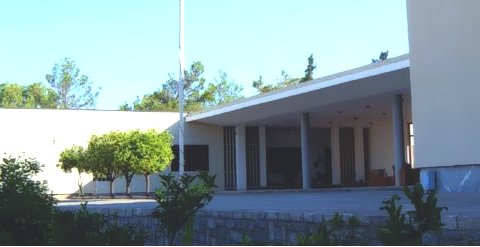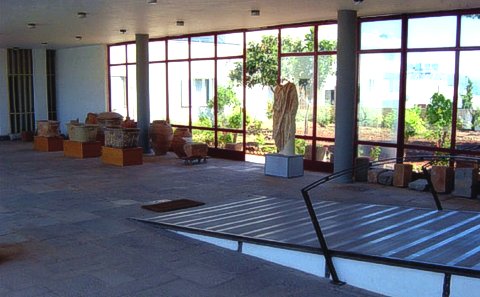The Museum of Aghios Nikolaos was founded in 1970 in order to house the numerous new archaeological finds from eastern Crete, which until then, were housed in the Museum of Herakleion. Its collections include:
Finds from the Early Minoan (3000-2000 B.C.) cemetery at Aghia Photia of Seteia
Finds from the Early Minoan II settlement at Fournou Koryfi of Myrtos
Finds from the Early Minoan II-III (2600-2200 B.C.) cemetery on the islet of Mochlos
Finds from Middle Minoan (2000-1550 B.C.) peak sanctuaries: Petsophas, Modi, Traostalos, Kalamaki, Prinias, Etiani, Kephala Finds from the Late Minoan III (1400-1200 B.C.) tombs of Milatos and Kritsa
Finds from the Geometric deposit at Anavlochos Vrachasiou.
Finds from the Daidalic deposit at Seteia (beginning of 7th century B.C.)
Finds from the Archaic deposit at Olous (end of 7th-6th centuries B.C.)
Finds from Lato pros Kamara (modern Aghios Nikoalos) dated to Greek and Roman times

The most important exhibits are:
Finds from the cemetery of Aghia Photia which was located by the sea and included at least 300 graves, all dated to the Early Minoan II and III periods (2300 B.C.). The burials were accompanied by numerous offerings to the dead, including more than 1500 vases of various types (chalices, pyxis, kernoi, jugs, incense burners) as well as plenty of obsidian tools and bronze daggers. Strong Cycladic influence was evident in the cemetery.
Finds from peak sanctuaries of the Middle Minoan I period (2000 B.C.). They are votive offerings, mostly human figurines, animal figurines or clay imitations of human parts, all in oversimplified rendering. They are very important as they offer information on the dressing and hairstyling habits of the period, as well as the gestures of worship.
Gold diadem from the Early Minoan II-III (2600-2200 B.C.) cemetery on the islet of Mochlos. It is decorated with schematic representations of Cretan wild goats in repousse dotted technique. The lower part is irregularly cut and on the upper are attached three V-shaped antennae.
"Goddess of Myrtos". Libation vase in the shape of a woman, found in the Early Minoan II (2600-2300 B.C.) settlement on the hill of Fournou Koryfi at Myrtos. It has a bell-shaped body, without legs, and a very small head with rough rendering of facial details, supported on a very tall neck. The woman holds a beak-mouthed jug in the crook of her arm. The details of the garment and the pubic triangle are painted.
Figurine of a worshiper or a priestess from the cemetery of Myrsine, at Seteia. The lower part of the body is formed as a low cylinder, with a cross painted under the base. On the upper part of the body, the schematic hands are brought before the breasts in a worshipping gesture. The hair in the back is formed as a horizontal cylinder, while other details of the face and the garment were painted. Dated to the Post-palatial period (after 1500 B.C.).
Gold pin. It had been exported illegally from Crete and was bought in Brussels by the archaeologist J.-P. Olivier, who donated it to the museum in 1981. The back face bears an exceptionally large inscription of 18 tiny Linear A signs, while the front is decorated with a bramble motif.
Small stone pyxis from the north cemetery at Gournia. The decorative groves are restricted to minimum so as not to hide the wonderful physical patterning of the stone, which the artist has exploited in a very skilful manner. The lid has a small handle at the centre. This kind of vase was used for keeping cosmetics or some kind of valuable material.
Head of a clay statue, found in a Daidalic-Archaic deposit at Seteia (7th-6th centuries B.C.). It is smaller than life and hollow inside. The pupils of the large eyes are marked with a compass. The expression, with the slight smile, is typical of the Archaic period. The statue had painted decoration, but only faint traces of the paint are preserved, as in the eyebrows, which were blue.
Skull of a young athlete with a gold wreath, found in the Roman cemetery of the city of Lato pros Kamara (modern Aghios Nikolaos), dated to the 1st century A.D. The wreath, fastened on the skull, is made of schematic olive-tree leaves. An silver tetradrachm of the city of Polyrrhenia from the time of emperor Tiberius had been placed in the mouth of the deceased as the fare for Charon.
Triton-shell rhyton (ritual vessel) found in the palace of Malia. It is made of green stone and bears a relief representation of two lion-headed demons who stand on a stepped structure, possibly an altar, and are in the process of a libation. One of them is holding a jug. The vase is dated to the Late Minoan I A period (1550-1500 B.C.).

Information for the visitors
Telephone :003028410 24 943
Tickets :
The museum is closed due to works. There is a temporary exhibition (with posters only) titled "The history of the city of Agios Nikolaos" (08:00 - 15:00 except Mondays).
Address
74 Konstantinou Palaiologou Str., Τ.Κ. 72100, Agios Nikolaos
More (www.culture.gr)...